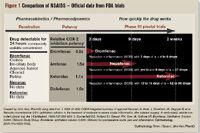Article
Ophthalmic NSAIDs vary in amount, time needed to reduce inflammation
Topical ophthalmic nonsteroidal anti-inflammatory drugs vary considerably in characteristics such as the number of days and the number of drops needed to reach the therapeutic endpoint. Although all are effective, doctors should learn to compare the NSAIDs based on their potency and penetration to make the best decisions for their patients.

Key Points

"All three of the NSAIDs are efficacious; they all certainly work, and I've used them all with my own patients. As a doctor, your selection of the NSAID should be based upon your clinical results. For me, that's most often tied to the penetration of the drug as well as the potency," said Uday Devgan, MD, an ophthalmologist in private practice in Los Angeles who conducted the comparison.
Other factors to consider are patient comfort with the drop and dosing, which affect compliance, continued Dr. Devgan, who also is chief of ophthalmology at Olive View-UCLA Medical Center.
The primary structural difference between the two newer-generation NSAIDs, amfenac and bromfenac, is the halogen molecule bromine in bromfenac, he said. "When you add a halogen to any drug, not just eye drugs, it usually increases the penetration and increases the potency of the drug. The addition of the bromine gives bromfenac a stronger effect. You don't need to have a higher concentration to have the same effect within the eye."
He continued: "You want to have the best penetration because you want to have the active drug in the target tissue. If you put the drug in the eye and it immediately runs right toward your target tissue, that's great penetration. For prevention of cystoid macular edema, my goal is a good level of NSAID in the macula and not necessarily in the vitreous. Potency means that you only need a small volume to achieve your effect. It may be easier and more efficient to get a little bit of drug to the target tissue than it is to get a lot of drug there."
Penetration (the ability to pass the corneal epithelium) was evaluated by assessing the rate-determining barrier; a CLogP level ≥1.6 was needed for penetration. Bromfenac had a CLogP level of 2.23 for the best penetration; ketorolac, 1.8, and nepafenac, ~1.6, had the next best levels. At a level of 1.23, amfenac was unable to penetrate the corneal epithelium; this pro-drug is modified to nepafenac for administration into the eye, where it then hydrolyzes and reconverts to amfenac, the active drug, to counter inflammation.
Potency was evaluated through comparison of IC50 strengths, the concentration of enzyme necessary to inhibit 50% of the enzyme activity. The lower the IC50 value, the less amount of drug is required to achieve therapeutic effect and the greater its potency, Dr. Devgan explained.
Bromfenac had the strongest activity against cyclooxygenase-2, the primary mediator for ocular inflammation and pain. The IC50 levels and relative potency of the topical NSAIDs were: bromfenac, 0.0075 µm (4.0x); amfenac, 0.0204 µm (1.5x); ketorolac, 0.0279 µm (1.1x); and diclofenac, 0.0307 µm (1.0x).




